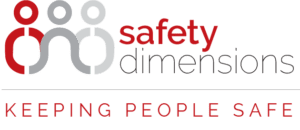
Safety training not only equips your workforce with the necessary expertise to safeguard their well-being and manage risk but also enhances your business performance.
For over 30 years Safety Dimensions has been a leading safety training specialist, empowering businesses with the knowledge and skills to prioritise workplace health and safety.
Here are the top benefits of training your people in safety:
Keep your most valuable asset safe – your people:
Regardless of the industry you operate in, investing in safety training is essential for protecting your most valuable asset: your people. Comprehensive safety training programs should cater to your industry, enabling your employees to identify potential hazards, mitigate risks and proactively address safety concerns. By prioritising the well-being of your workforce, you demonstrate a commitment to their safety and establish a strong foundation for long-term success.
Manage risk and ensure compliance:
In today s regulatory landscape, compliance with WHS laws and industry standards is crucial. Our safety training programs ensure that your business meets legal obligations, adheres to industry-specific guidelines and stays abreast of the Model WHS Act and Regulations. Through our comprehensive training, your workforce will develop a deep understanding of risk mitigation strategies, incident response protocols and effective WHS management practices. By proactively managing risks you can reduce workplace incidents, enhance compliance and safeguard your employees from potential harm.
Foster a culture of safety:
Investing in safety training goes beyond meeting legal requirements; it fosters a culture of safety within your organisation. By enrolling your supervisors, managers and frontline staff in our programs, such as the BSB41419 Certificate IV in Work Health and Safety, you equip them with the knowledge and skills to champion safety practices. This investment demonstrates your commitment to their growth and well-being. A strong safety culture boosts morale, increases employee loyalty and retention and sets the stage for sustained success.
Drive efficiency and productivity:
Safety and productivity go hand in hand. Through WHS training programs, your employees gain a comprehensive understanding of hazard identification, risk management and incident response. This empowers them to proactively address potential hazards which leads to fewer disruptions, enhance efficiency and timely project completion. By equipping your workforce with the necessary safety skills, you create a work environment that not only prioritises their well-being but also drives productivity and operational excellence.
Enhance reputation and business opportunities:
Prioritising safety training doesn’t only safeguard your employees but it has the added benefit of enhancing your reputation as a responsible business partner. By investing in safety training programs, you build a strong reputation for safety consciousness and reliability which can unlock new business opportunities and position your organisation as a trusted industry leader. Your commitment to safety becomes a competitive advantage, differentiating you from competitors and fostering long-term business growth.
Cost savings and sustainable success:
Safety training is not just an expense; it is an investment that yields substantial cost savings and contributes to long-term business sustainability. By minimising or eliminating workplace incidents, you can reduce workers’ compensation claims, insurance premiums, and potential legal expenses. Safe working environments also minimise disruptions and downtime, optimising productivity and resource allocation. Our safety programs empower you to create a culture of safety, ensuring cost savings and driving sustainable success for your business.
Safety is a leadership competency:
Safety starts at the top. Effective leadership plays an essential role in fostering a culture of safety within an organisation. Managers and supervisors serve as the driving force behind promoting and reinforcing safety practices among employees. Their commitment, active participation and leading by example can significantly influence the overall safety culture.
Strong safety leadership involves setting clear expectations for safety performance, providing the necessary resources and training and actively involving employees in safety initiatives. By prioritising safety in decision-making processes and demonstrating a genuine concern for the well-being of their teams, leaders create an environment where safety becomes ingrained in the organizational DNA.
Managers and supervisors have the power to influence the attitudes and behaviours of frontline staff, shape safety protocols and motivate employees to actively participate in safety programs and ‘speak up’. Their role needs to extend beyond enforcement; they need to become champions of safety by encouraging open communication, recognising achievements and addressing safety concerns promptly. By empowering leaders with the knowledge and skills to drive a safety culture, organisations can achieve long-term success in minimising incidents and fostering a safer work environment.
Continuous improvement and evaluation:
Safety is an ongoing journey, and organisations must continuously evaluate and improve their safety practices to ensure effectiveness and adapt to evolving risks. Regular evaluation and analysis of safety protocols, incident data and near-miss reports provide valuable insights for identifying areas of improvement and preventing future incidents.
Conducting regular safety audits and inspections allows organisations to proactively identify hazards, assess control measures and implement corrective actions. By involving employees in the evaluation process and encouraging their input, organisations tap into the collective wisdom and experience of their workforce, fostering a culture of safety ownership.
Continuous improvement also involves staying up to date with regulatory changes, industry advancements and emerging best practices. By incorporating new knowledge and technologies into safety training programs, organisations can ensure that their employees are equipped with the latest tools and information to mitigate risks effectively.
This commitment not only protects employees but also contributes to operational efficiency, productivity and long-term success.
Put mental health on equal footing with physical safety:
Is it vital to recognise the profound connection between physical and mental well-being. A safe and healthy work environment encompasses not only the absence of physical hazards but also the promotion of positive mental health. WHS regulations have also recently been (or are soon to be in each state and territory) amended to make psychosocial safety part of your WHS legal obligations. See more here >>
Psychosocial hazards, such as excessive work demands, lack of support, and poor workplace relationships, can have a significant impact on employees’ mental well-being. Recognising and addressing these hazards is essential to creating a holistic approach to workplace safety.
By integrating mental health and well-being into safety training, organisations demonstrate their commitment to the overall health of their employees. Training programs can help employees identify signs of stress, burnout, or other mental health challenges and provide them with resources and strategies to cope effectively. Fostering a supportive work environment that encourages open dialogue, promotes work-life balance, and offers access to mental health support services contributes to a safer and healthier workforce.
For better outcomes, tailor safety training solutions to your specific needs.
If you’re serious about safety, generic safety training simply won’t cut it. Each industry has its unique set of hazards, risks, and regulatory requirements that demand specialised attention. That’s why LDN s tailored Safety Dimensions training solutions are essential for organisations committed to ensuring the safety and well-being of their workforce.
By understanding and applying training to the intricacies of your industry, our suite of safety programs and solutions, including the BSB41419 Certificate IV in Work Health and Safety or 11045NAT Certificate IV in Safety Leadership, provide targeted and relevant education that goes beyond generic safety protocols and take into account industry-specific hazards, regulations, and best practices.
Regardless of your industry, our instructional designers will work closely with you to develop a training plan that addresses your unique safety challenges, ensuring that your leaders and employees receive the knowledge and skills necessary to navigate their work environments safely.







